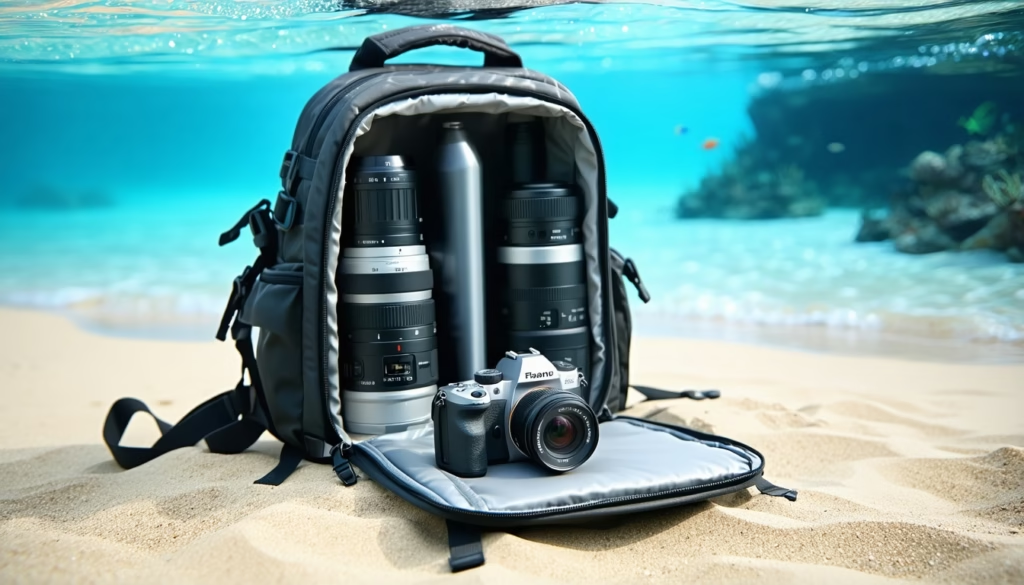How To Use A Camera Backpack For Underwater Gear

If you’re heading underwater with photo gear? Learning how to use a camera backpack for underwater gear is key. This friendly guide walks you through choosing, packing, and maintaining your dive pack step by step.
Whether you shoot wide angle reefs or macro sea life, you’ll find clear tips for every dive. Let’s dive in.
Choose Waterproof Camera Backpack
Your backpack’s main job is to keep water out, so start by picking the right pack.
Check Material And Seals
Look for strong nylon or coated polyester and welded seams (these prevent leaks). Here’s what to check.
- Coated fabric or PVC liner
- Double-stitched seams with seal tape
- Waterproof zipper covers or flaps
Confirm Size And Capacity
Make sure your pack fits housings, battery grips, strobes, and other underwater camera gear. Consider these points.
- Look for 20 to 30 liters capacity
- Check internal dimensions against your largest housing
- Plan room for personal items like snacks or dive logs
Inspect Straps And Supports
You’ll carry extra weight when you add cameras and dive gear. Good straps keep things comfy.
- Padded shoulder straps and hip belt
- Chest and waist straps to balance weight
- Ventilated back panel for airflow
Prepare Underwater Equipment
Before loading your backpack, gather every piece of underwater camera equipment you need.
Gather Camera Housings
Clean and test your underwater housing for leaks before packing.
- Inspect O-ring (lubricate lightly)
- Check port glass for scratches
- Test buttons and dials under water in a bucket
Pack Spare Seals And O-rings
A small damaged seal can flood your camera, so bring backups.
- Keep O-rings in a labeled container
- Carry extra grease and seal lubricant
- Store them in a dry, cool pocket
Include Cleaning Supplies
Rinse and remove salt after each dive to avoid corrosion.
- Microfiber cloths for lens and housing
- Small brush for salt-prone areas
- Lens cleaning solution in travel size
Organize Gear Inside Compartments
Sorting items quickly helps you grab the right tool underwater. Let’s set up an easy layout.
Use Modular Dividers
Moveable dividers let you shape compartments to fit odd housings.
- Arrange dividers before each trip
- Create snug slots to reduce camera movement
- See our guide on how to customize a camera backpack with inserts
Store Lenses Safely
Lenses can shift and scratch if loose, so give each its own spot.
- Use padded lens pouches
- Label each pouch for quick ID
- Check best ways to organize lenses inside a camera backpack
Secure Small Accessories
Memory cards and mounts can be tiny but essential.
- Store cards in a hard case (see the safest way to store memory cards in a backpack)
- Keep cables in ziplock pouches
- Avoid loose clips that jam zippers
Add Moisture Protection Layers
Even waterproof packs can trap moisture inside, so add extra layers.
Insert Silica Gel Packs
These little packets soak up humidity before it damages electronics.
- Place one pack per liter of volume
- Replace packets when saturated
- Store extras in your dive kit
Use Dry Bags Or Pouches
Additional water-tight pouches create a second barrier for sensitive items.
- Pack cables and batteries inside sealable dry bags
- Keep your essential items in a separate pouch
- Check weatherproofing tips for your camera backpack
Adjust And Wear Backpack
A poorly fitted pack causes fatigue, so adjust carefully.
Fit Straps Comfortably
Straps should hug your body without squeezing you too hard.
- Tighten shoulder straps evenly
- Use the hip belt to shift weight
- Adjust chest strap to prevent bounce
Balance Weight Properly
Keep heavy items close to your back for stability.
- Place housings near the spine
- Lighter gear can sit at the top
- Learn more about weight balance in how to balance weight in a camera backpack
Lock Zippers Securely
Zippers can fail under pressure, so lock them when you dive.
- Use zipper locks or small padlocks
- Check that pulls align properly
- Keep critical items in interior pockets
Clean And Maintain Backpack
After each trip, give your pack a quick refresh to keep it in top shape.
Rinse With Fresh Water
Salt and sand degrade materials, so rinse your backpack well.
- Use a gentle shower setting
- Flush zippers, seams, and pockets
- Check our tips on how to clean and maintain a camera backpack
Air Dry Thoroughly
Let your pack dry out completely to prevent mold growth.
- Hang it open in a shaded area
- Prop pockets open for airflow
- Avoid direct sun, which can fade fabric
Inspect For Damage
Look for seal wear, loose stitching, or broken buckles before your next dive.
- Replace worn O-rings and seals
- Sew or reinforce weak seams
- Swap broken buckles to keep pack secure
FAQs:
How Do I Choose A Backpack For Underwater Use?
Look for a camera pack built from waterproof materials, sealed zippers, and welded seams for safe diving.
Can I Use A Standard Camera Backpack Underwater?
Standard packs lack proper seals and waterproof ratings. Always pick a pack designed for underwater gear.
What Moisture Protection Should I Pack?
Silica gel packets, dry bags, and extra waterproof pouches help keep electronics safe.
How Do I Balance Heavy Equipment?
Place heavier items close to your back and center, then adjust straps to distribute the weight evenly.
How Often Should I Clean My Dive Pack?
Rinse and air dry after every saltwater dive. Inspect seals and fabric monthly for wear.
Conclusion
Using a camera backpack for underwater gear doesn’t have to feel complicated. By choosing the right pack, organizing thoughtfully, and adding moisture protection, you’ll dive with confidence.
Give these tips a try next time you suit up and see how smooth your dive goes. Got a hack for packing your underwater camera gear? Share it in the comments below.


